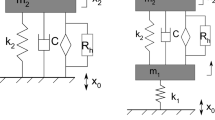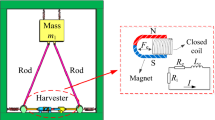Abstract
The aim of this study is to optimize the electromagnetic vibration energy harvesters with typical cylindrical shape considering the aspect ratio. In the optimization procedure, voltage and power, which are two key factors of energy harvesting systems, are mainly considered in the three types of electromagnetic vibration energy harvester according to various aspect ratios. We then investigate the optimum design parameters in each case. The results show that there is an optimum aspect ratio that maximizes the output voltage and power for the same volume. We also find that the optimum design parameters for each aspect ratio have a relatively constant value regardless of the aspect ratio. An experimental study is also conducted to verify the simulation results of the design optimization, and it clearly confirms that the proposed optimization result matches the experimental results well.









Similar content being viewed by others
References
Spreemann, D., & Manoli, Y. (2012). Electromagnetic vibration energy harvesting devices: Architectures, designs, modeling and optimization, advanced microelectronics (Vol. 35). New York: Springer.
Beeby, S. P., Torah, R. N., Tudor, M. J., et al. (2007). A micro electromagnetic generator for vibration energy harvesting. Journal of Micromechanics and Microengineering, 17, 1257–1265.
And, Williams C., & Yates, R. (1996). Analysis of a micro-electric generator for microsystems. Sensors and Actuators, A: Physical, 52, 8–11.
Arnold, D. P. (2007). Review of microscale magnetic power generation. IEEE Transactions on Magnetics, 43(11), 3940–3951.
Kim, J. E., Kim, H. J., Yoon, H. S., & Kim, Y. Y. (2015). An energy conversion model for cantilevered piezoelectric vibration energy harvesters using only measurable parameters. International Journal of Precision Engineering and Manufacturing-Green Technology, 2(1), 51–57.
Jin, J. W., Kim, J. H., & Kang, K. W. (2015). Development of durability test procedure of vibration based energy harvester in railway vehicle. International Journal of Precision Engineering and Manufacturing-Green Technology, 2(4), 353–358.
Park, H. C., & Kim, J. H. (2016). Electromagnetic induction energy harvester for high speed railroad applications. International Journal of Precision Engineering and Manufacturing-Green Technology, 3(1), 41–48.
Park, H. C. (2017). Vibration electromagnetic induction energy harvester on wheel surface of mobile sources. International Journal of Precision Engineering and Manufacturing-Green Technology, 4(1), 59–66.
Kim, J. H., Shin, Y. J., Chun, Y. D., & Kim, J. H. (2018). Design of 100 W regenerative vehicle suspension to harvest energy from road surfaces. International Journal of Precision Engineering and Manufacturing-Green Technology, 19(7), 1089–1096.
Spreemann, D., Hoffmann, D., Folkmer, B., & Manoli, Y. (2008). Numerical optimization approach for resonant electromagnetic vibration transducer designed for random vibration. Journal of Micromechanics and Microengineering, 18(10), 104001.
Spreemann, D., Folkmer, B., & Manoli, Y. (2008). Comparative study of electromagnetic coupling architectures for vibration energy harvesting devices. Proceedings of the Power MEMS, 2008, 257–260.
Cepnik, C., & Wallrabe, U. (2010). Practical and theoretical limits of the output power of electromagnetic energy harvesters at miniaturization. Proceedings of the Power MEMS, 2010, 69–72.
Cepnik, C., Yeatman, E. M., & Wallrabe, U. (2012). Effects of nonconstant coupling through nonlinear magnetics in electromagnetic vibration energy harvesters. Journal of Intelligent Material Systems and Structures, 23, 1533–1541.
Kim, S. C., Kim, Y. C., Seo, J. H., & Lee, H. M. (2017). Design optimization of electromagnetic vibration energy harvesters considering aspect ratio. The Korean Society for Noise and Vibration Engineering, 27(3), 360–371.
Stephen, N. G. (2005). On energy harvesting from ambient vibration. Journal of Sound and Vibration, 293(1–2), 409–425.
Cepnik, C., Radler, O., Rosenbaum, S., et al. (2011). Effective optimization of electromagnetic energy harvesters through direct computation of the electromagnetic coupling. Sensors and Actuators, A: Physical, 167(2), 416–421.
Lee, H. M., Kim, Y. C., Lim, J. W., et al. (2014). Design optimization process for electromagnetic vibration energy harvesters using finite element analysis. Transactions of the Korean Society for Noise and Vibration Engineering, 24(10), 809–816.
Owen, A. (1992). Orthogonal arrays for computer experiments, integration, and visualization. Statistica Sinica, 2(2), 439–452.
IEC 60317. (2013). Specifications for particular types of winding wires.
Acknowledgements
This study is a research carried out with the support of the Korea Institute of Machinery and Materials in 2016.
Author information
Authors and Affiliations
Corresponding author
Additional information
Publisher's Note
Springer Nature remains neutral with regard to jurisdictional claims in published maps and institutional affiliations.
Rights and permissions
About this article
Cite this article
Kim, SC., Kim, JG., Kim, YC. et al. A Study of Electromagnetic Vibration Energy Harvesters: Design Optimization and Experimental Validation. Int. J. of Precis. Eng. and Manuf.-Green Tech. 6, 779–788 (2019). https://doi.org/10.1007/s40684-019-00130-4
Received:
Revised:
Accepted:
Published:
Issue Date:
DOI: https://doi.org/10.1007/s40684-019-00130-4




